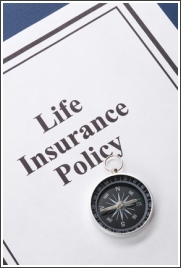
Term or Permanent Life Insurance – How do you know if you have the right
coverage?
 Here’s a quick look at all of the options: Term, Whole,
Variable and Universal
Here’s a quick look at all of the options: Term, Whole,
Variable and Universal
Few people who have bought life insurance — or even window-shopped for
it – have escaped the debate over term vs. permanent insurance.
And the wrong kind of life
insurance can do more damage to your financial plans than just about any
other financial product today. So, the first and most important decision
you must make when buying life insurance is: term, permanent or a
combination of both? Let’s look at each.
Term life policies offer death
benefits only; so if you die, you win (so to speak). If you live past
the length of the policy, which is quite probable, you or more
specifically your family members get no money back.
Term policies or better stated
temporary policies are cheap and for a very good reason – they are a
“cash cow” for the life insurance companies with less than a 2% chance
any given policy owner will die and “cash out” during the life of his or
her term.
PERMANENT LIFE INSURANCE IS MORE EXPENSIVE
And for a very good reason – If
kept long enough it is guaranteed to pay out to your beneficiaries.
Permanent life policies offer death benefits and a "savings account"
(also called "cash value") so that if you live you get back at least
some of and often much more than, the amount you spent on your premium.
You get this money back either by cashing in the policy or by borrowing
against it. Look at permanent life insurance as a forced savings account
for life.
As you might expect, permanent
life insurance premiums are more expensive than term premiums because
some of your premium dollars are put into a savings program. The longer
the policy has been in force, the higher the cash value, because more
money has been paid in and the cash value has earned interest, dividends
or both.
The debate is all about that
cash value. If you buy a policy today, your first annual premium is
likely to be much higher for a permanent life policy than for term. Is
this a bad thing? Not necessarily if your goal is long term savings
towards retirement and the inability to never outlive your life
insurance policy (currently up to age 121).
LET
LIFE INSURANCE LIVE
However, the good news is
premiums for permanent life stay the same over the years, while the
premiums for term life can increase over time. That extra premium paid
in the early years of the permanent policy gets invested and grows,
minus the cost of insurance (COI) the life insurance company takes back.
The gain is tax-deferred if the policy is cashed in during your life.
(If you die, the proceeds are usually tax-free to your beneficiary.) And
you are allowed to borrow against your cash value should you ever need
an infusion of cash or you wish to retire and supplement your retirement
income.
The question or debate you
always hear is, "Buy term and invest the difference." The fact is it
really depends on how long you keep your policy. If you keep the
permanent life policy long enough (and in the unlikely event the market
ever fully rebounds), that’s the best deal. But "long enough" varies
depending on your age, health, insurance company, the types of policies
chosen, interest and dividend rates, and more. The reality is that there
is not a simple answer, because life insurance is not a simple product.
If you wish to unravel the mysteries of what life insurance policy is
good for you and your family, just give us a call. And yes, there are
some times we point out that a life policy may not be in your best
interests.
SIMPLE GUIDELINES
Even with all of these
variables, there are some simple guidelines you can follow. The key is
how long you plan to keep the policy. If the answer is less than 10 or
20 years, term is clearly the solution.
If it is more than 20 years,
permanent life or a combination is probably the way to go. The big gray
area is in between. Here is where we can help to run the term vs.
permanent analysis for you. Of course, this assumes you keep the policy
in force. Most people drop their policies within the first 10 years, but
if you do your homework now, that shouldn’t be the case for you.
HOW TO CHOOSE
Categorize your insurance needs by their use. If you need $60,000 for
college and your youngest child will graduate in three years, you need
$60,000 of term insurance as a short-term hedge against your death, thus
insuring that your child can finish his or her education. Meanwhile, if
your estate will owe $200,000 in taxes at your death or you are gearing
up for retirement, you probably need permanent insurance, because you’re
not likely to die in the next 20 years (you hope). You also may want to
re-evaluate your estate plan, but that’s a different issue discussed
elsewhere on our website.
And, there are many cases with a
combination of both temporary and permanent life insurance makes sense
and works best.
There is help available for everyone making these choices and there is no cost to you for our advice. Just give us a call at 727-424-2424.
